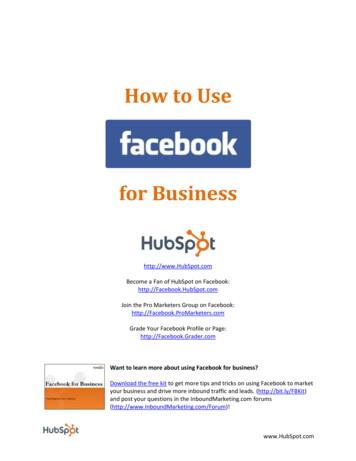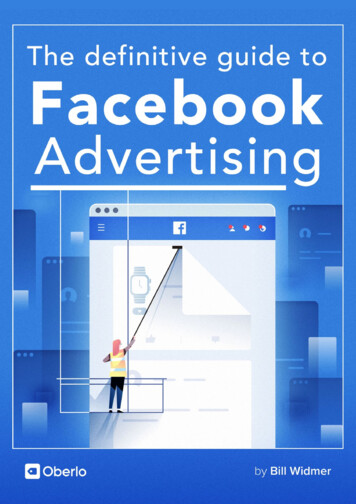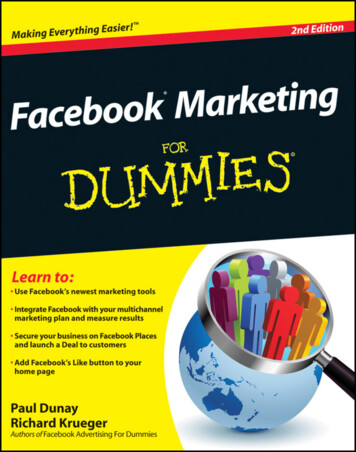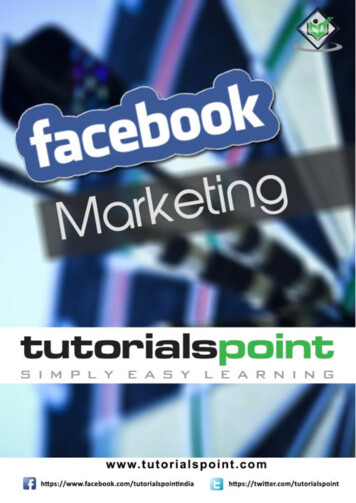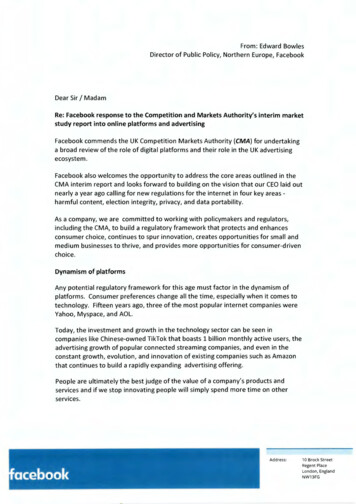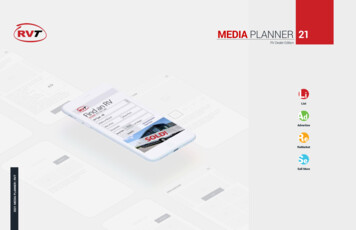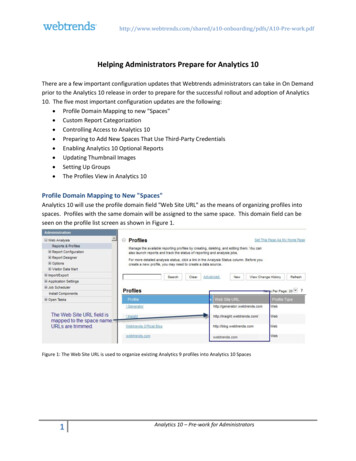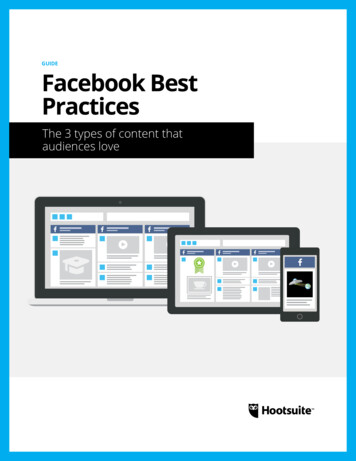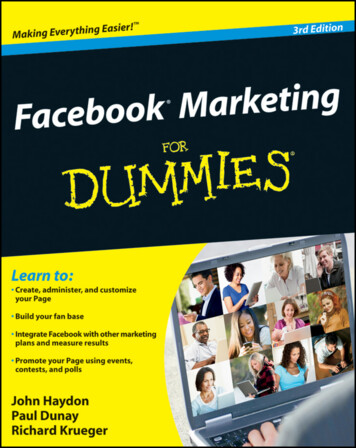
Transcription
Facebook Marketing For Dummies,rd3 EditionChapter 3: Developing a FacebookMarketing PlanISBN: 978-1-118-10740-9Copyright of John Wiley & Sons, Inc.Indianapolis, IndianaPosted with Permission
IntroductionWith more than 800 million active users and 250,000 new registrantsevery day, Facebook has become a virtual world unto itself. Harvarddropout Mark Zuckerberg originally started Facebook as a dorm room exerciseto extend the popular printed college directory of incoming freshmen online,but he has since developed it into an international organization employingmore than 2,000 programmers, graphic artists, and marketing and businessdevelopment executives with offices across the United States as well as inDublin, London, Milan, Paris, Stockholm, Sydney, and Toronto. These days, onaverage, more than 2 billion posts are liked and commented on, and more than250 million photos are uploaded to Facebook every single day!For many, Facebook is a social experience, a place to reconnect with an oldcollege chum or poke a new friend. But in April 2007, Zuckerberg did something so revolutionary that its aftershocks are still being felt throughoutthe business web. He opened his virtual oasis to allow anyone with a littleprogramming knowledge to build applications that take advantage of theplatform’s social graph (or network architecture). In that open software act,Facebook redefined the rules for marketers looking to gain access to socialnetworks, and it will never be business as usual again.About This BookFacebook Marketing For Dummies provides you, the marketer, with in-depthanalysis of the strategies, tactics, and techniques available to leverage theFacebook community and achieve your business objectives. By breakingdown the web service into its basic features — including creating a FacebookPage for your business, adding applications for your Page, hosting an event,creating a Facebook group, advertising, and extending the Facebook platformto your website through social plug-ins — we lay out a user-friendly blueprintto marketing and promoting your organization via Facebook.03 9781118107409-intro.indd 11/9/12 11:49 PM
2Facebook Marketing For Dummies, 3rd EditionFoolish AssumptionsWe make a few assumptions about you as the marketer and aspiringFacebook marketing professional: You are 14 years of age or older, which is a Facebook requirement forcreating your own profile. You’re familiar with basic computer concepts and terms. You have a computer with high-speed Internet access. You have a basic understanding of the Internet. You have your company’s permission to perform any of the techniqueswe discuss. You have permission to use any photos, music, or video of your company to promote it on Facebook.Conventions Used in This BookIn this book, we stick to a few conventions to help with readability. Wheneveryou have to enter text, we show it in bold so it’s easy to see. Monofont textdenotes an e-mail address or URL (for example, www.facebook.com).When you see an italicized word, look for its nearby definition as it relates toFacebook. Numbered lists guide you through tasks that must be completedin order from top to bottom; bulleted lists can be read in any order you like(from top to bottom or bottom to top).Finally, we often state our opinions throughout the book. We’re avid marketers of the social network medium and hope to serve as reliable marketingtour guides to share objectively our passion for the social network.What You Don’t Have to ReadThis book has been designed to be a modular guide to Facebook marketing.You don’t need to read the book in a linear fashion, chapter-to-chapter,but rather you can use the book as a research tool to help you marketyour company on Facebook. You can also use the index to find exactlythe topics that are of most interest to you. We’ve incorporated real-life03 9781118107409-intro.indd 21/9/12 11:49 PM
Introduction3marketing scenarios to help you get a sense of what has worked and notworked for other marketers using Facebook. Following are some otherhelpful guidelines to using this book: Depending on your existing knowledge of Facebook, you may want toskip around to the parts and chapters that interest you the most. If as a marketer you have a good working understanding of Facebook,you can skip the first two chapters. If you want to set up a Page for your business, go directly to Chapter 4. If you have a Page and want to start going viral with your marketing, godirectly to Part III. If you have a Page for your business and are interested in advertisingand promoting it, go directly to Part IV. Don’t read supermarket tabloids. They’re certain to rot your brain.How This Book Is OrganizedWe organized this book into five parts. Each part and the chapters within itare modular, so you can jump around from topic to topic as needed. Eachchapter provides practical marketing techniques and tactics that you can useto promote your business, brand, product, or organization in the Facebookcommunity. Each chapter includes step-by-step instructions that can helpyou jump-start your Facebook presence.Part I: Preparing for Successon FacebookAre you ready to add Facebook to your marketing mix? Before you cananswer that question, you have much to consider. Part I gives you an overview of some of the topics we discuss in detail in the book, such as how andwhy to build a presence on the social network, how to leverage content tobuild a fan base, how to put viral marketing features to work for you, andhow to build a winning strategy for your business. You need to make a subtlemind shift along the way that we can only describe as being more open andtransparent. Many companies struggle with this transition, but those thatembrace it go on to have a new level of relationships with their customersand prospects.03 9781118107409-intro.indd 31/9/12 11:49 PM
4Facebook Marketing For Dummies, 3rd EditionPart II: Building Your Facebook PresenceAll marketers young and old are looking to build a Facebook presence fortheir companies, small businesses, or clients. In this part, we show you howto secure a spot for your business on Facebook, how to design a great Page,and how to make promotions, groups, and events work for you. We also discuss how to cross-promote your Page and measure your Page’s fan engagement activity.Part III: Engaging with Your Customersand Prospects on FacebookHere we discuss the strategies for going public with your Page. In this section you learn how to promote your Page, engaging fans, and measuring yourcampaign’s success on Facebook. We show you specific strategies and tacticsthat have been proven to grow your fanbase and increase awareness of yourPage. We also show you how to measure success on Facebook so that youcan quickly find out what’s working and what’s not.Part IV: Marketing beyondthe Facebook PagePart IV helps you create a new source of revenue for your business. We tellyou how to advertise on Facebook by targeting a specific audience, creatingand testing your ads, and then measuring your ads’ success. We tell you howto use Groups, Events, and promotions to go beyond your Facebook Page.We also show you how to use social plug-ins to integrate Facebook into yourwebsite.Part V: The Part of TensThe chapters in this part give some quick ideas about how to conduct yourself on Facebook in a way that best meets your business goals, and what topbusiness applications you can use on your Facebook Page. We also show youthe most common mistakes to avoid.03 9781118107409-intro.indd 41/9/12 11:49 PM
Introduction5Icons Used in This BookThis icon points out technical information that’s interesting but not vital toyour understanding of the topic being discussed.This icon points out information that is worth committing to memory.This icon points out information that could have a negative impact on yourFacebook presence or reputation, so please read the info next to it!This icon points out advice that can help highlight or clarify an importantpoint.Where to Go from HereIf you’re new to Facebook and an aspiring Facebook marketer, you may wantto start at the beginning and work your way through to the end. A wealth ofinformation sprinkled with practical advice awaits you. Simply turn the pageand you’re on your way.If you’re already familiar with Facebook and online marketing tactics, you’rein for a real treat. We provide you with the best thinking on how to marketyour business on Facebook based, in part, on our own trials and tribulations. You might want to start with Part II of the book, but it wouldn’t hurtto take in some of the basics in Part I as a reminder and read about some ofthe new menus and software features. You’re sure to pick up something youdidn’t know.If you’re already familiar with Facebook and online marketing tactics butshort on time (and what marketing professional isn’t short on time?), youmight want to turn to a particular topic that interests you and dive right in.We wrote the book in a modular format, so you don’t need to read it fromfront to back, although you’re certain to gain valuable information from acomplete read.03 9781118107409-intro.indd 51/9/12 11:49 PM
6Facebook Marketing For Dummies, 3rd EditionRegardless of how you decide to attack Facebook Marketing For Dummies,we’re sure that you’ll enjoy the journey. If you have specific questions orcomments, please feel free to reach out to us via John’s Facebook Page atwww.facebook.com/inboundzombie. We’d love to hear your personalanecdotes and suggestions for improving the future revisions of this book.And in the true spirit of sharing on which Facebook is built, we promise torespond to each of your comments.Occasionally, we have updates to our technology books. If this book doeshave any technical updates, they will be posted at e’s to your success on Facebook!03 9781118107409-intro.indd 61/9/12 11:49 PM
Chapter 3Developing a FacebookMarketing PlanIn This Chapter Figuring out what to include in your marketing plan Developing your value proposition Getting to know your audience Identifying your marketing goals Creating engaging content and measuring your results Integrating your offline and online campaignsOne of the great things about Facebook is that it gives you access to avery large and growing audience at relatively low or even no cost. Allthat’s needed is some sweat equity on your part, but that doesn’t mean youshouldn’t have a strategy for what you want to achieve for your business.Whether you’re a small business owner, an artist, a celebrity, or you sell awell-known (or soon to be well-known) product or service, you need to thinkabout who your audience is and what they want. This chapter helps youdecide what message you want them to receive and which Facebook tacticswill get them to interact with that message.Understanding What to Includein Your Marketing PlanSocial networks represent a shift in the way that people use the Internet.Rather than just search for information, Facebook members can search forand interact with like-minded people who have similar interests.Traditional marketing methods like print or TV ads are limited in that theycan only shout at, so to speak, your customers to get them to buy something.07 9781118107409-ch03.indd 271/9/12 11:50 PM
28Part I: Preparing for Success on FacebookThis approach doesn’t work in a social network like Facebook because theusers expect dialogue. For this reason, a shouting approach isn’t only lesseffective than other methods — it might even work against you.Over time, even marketing on Internet media has undergone a dramatic evolution. Websites once represented a kind of one-way communication, onein which visitors could only view content. This was followed by blogs andforums, which allowed visitors to comment on content, and then networkslike Myspace and Facebook came along and really gave friends the ability toconnect with each other. Finally, tools like Twitter and Foursquare allowedfor real time conversations with all people (not just friends), and even toshare their real-world locations within those conversations. (See Figure 3-1.)With Facebook and other social networks, your business can take advantageof technology that promotes your business by word of mouth. For example,when a Facebook user becomes a fan of your company’s Page, confirmsattendance at your Facebook event, or installs your application on his profile,these actions are automatically turned into stories that appear on the user’sWall. In essence, the user passes along your marketing message to otherFacebook members, expanding word-of-mouth awareness of your business —without any extra effort.Figure 3-1:The adventof socialnetworkshas influenced howpeople connect withbrands.07 9781118107409-ch03.indd 281/9/12 11:50 PM
Chapter 3: Developing a Facebook Marketing Plan29Before you can take full advantage of the marketing power of Facebook, youneed to put together a Facebook marketing plan, which is a structured wayto align your strategies with your objectives. Here are the general steps forcreating your plan:1. Develop your value proposition.2. Understand your audience.3. Define your marketing goals.4. Develop a content strategy.5. Monitor and measure your Page activities.6. Integrate your online and offline campaigns.The rest of this chapter explains each of these steps in more detail. By putting these steps into practice, you can begin to put your marketing strategyin place by the end of this chapter.Developing Your Value Proposition:Why Should Customers Buy WhatYou’re Offering?When developing a formal marketing plan, the first thing you need to consider is your organization’s value proposition, or Unique Selling Proposition(USP), which describes how your company is different from the competitionand why people should do business with you. You may have a different valueproposition for each audience segment you target, or for each product or service you offer. Your marketing plan should detail the ways in which you planto communicate these values to your target audience.To understand your value proposition, answer the following questions: How are you different from your competitors? By knowing your competition and what separates your offering from theirs, you can begin todevelop your product differential, a key ingredient that goes into yourvalue proposition. So what makes your product or service differentfrom — and better than — your competitors? The answer to this question is what sets you apart from them. Do you offer a longer free trialof your product than your competitors? Do you have the ability totailor your service to meet your customers’ exact needs? Whateverthat difference is, exploit it.07 9781118107409-ch03.indd 291/9/12 11:50 PM
30Part I: Preparing for Success on Facebook What value do you provide to your stakeholders? Stakeholders areyour customers, shareholders, employees, partners, and anyone elseimpacted by your company. Understanding the value you provide is keyin developing your messaging and communications strategy. By having aclear picture of what you want to accomplish with your marketing plan,you open a world of opportunities for your business. The key is communicating this to your stakeholders. When your employees know yourbrand messaging, they can pass that information on to your customersin the form of knowledge and better service. When your stakeholdersknow you have a clear plan of action, they’ll be more comfortable withthe direction that you’re taking the company, which leads to greatersupport for your future ideas and plans. What are your big-picture goals? Some goals are more obvious thanothers. They could include increasing company sales or driving moretraffic to your website, both of which can be done when you clearlydefine and communicate your value proposition. Some aren’t as obvious, such as improving your company’s reputation or creating a morefriendly face for the brand. Whatever your company’s goals, make sureall of your Facebook marketing activities align with these goals.Understanding Your AudienceWhatever your business goals, always assemble the best information thatyou can about your audience. The better you understand the culture andviewpoints of your audience — what they like and don’t like, where theyspend their time, and what information sources they rely on — the moreeffectively you can capture their attention and deliver your message.Understanding the lives of your customers and prospects is key when communicating your business or product to them.Finding out what makes your fans tickFacebook provides some powerful insights into your fans. In fact, identifying and then reaching a specific audience has never been this exact andcost-effective. The Facebook Insights tool helps you find out more aboutwho visits your Facebook Page, including a demographic and interestbreakdown of your fans, and the Facebook ad-targeting capabilities makeit relatively easy to get your message to the right target audience withinFacebook.07 9781118107409-ch03.indd 301/9/12 11:50 PM
Chapter 3: Developing a Facebook Marketing Plan31Understanding your fans’ psychographic profiles is an important element inknowing who they are. Psychographic variables (such as music a user loves,politicians he endorses, or causes he supports) are any qualities relating toa user’s personality, values, attitudes, interests, or lifestyles. These variablesare in contrast with demographic variables (such as age and gender) andbehavioral variables (such as usage rate or loyalty) and can help you betterunderstand your customer segments.Gathering this information can be fairly easy if you know where to look andhow to go about doing it. For example, ask your customers to fill out satisfaction surveys or a quick questionnaire through your e-newsletter or website.Another option is to search Facebook for some companies similar to yoursand read through the comments posted by their fans to see what makes themreturn to those companies.Psychographics is exceptionally relevant in any discussion of social networksbecause your target audience is more likely to interact with you along the linesof their interests, values, and lifestyles. Examples of this can be seen in Facebookapps similar to iLike, which integrates users’ favorite music and makes recommendations on their Profiles. Another example is Tom’s of Maine, a companythat produces all-natural personal care products such as toothpaste and soap.Tom’s of Maine takes advantage of the fact that many people are concerned withmaking positive changes to their communities and the environment and are“going green.” In fact, its site has an entire tab devoted to fundraising outcomesand that creating positive change starts with each individual.Refer to Chapter 2 for more on developing personas to understand yourtarget market.Understanding whatmotivates your fansAfter you understand your target customers, you need to understand whatmotivates them. Customers want to feel as though they’re receiving specialtreatment on Facebook. They want to know that their support is important toyou and that their concerns are being heard. But most of all, they want something in return for their attention and loyalty. Facebook members love freestuff, special discounts, and promotions.It’s not surprising that Facebook members are looking for real value in theform of informative and engaging content from marketers on Facebook. Much07 9781118107409-ch03.indd 311/9/12 11:50 PM
32Part I: Preparing for Success on Facebooklike in Google Search, in which users are further down the intent-to-purchaseroad by the very nature of their searches, Facebook users aren’t necessarilylooking for specific products and services to purchase. That’s why marketersneed to grab their attention through special offers.Special incentive offers can be found throughout Facebook in the form of adson Facebook Pages. In Figure 3-2, Ann Taylor offers a 30 percent discount justfor becoming a fan of its Facebook Page.Figure 3-2:Ann Tayloroffers fansa discountpromotionbut requiresthey likethe Page toredeem it.Although pricing discounts serve as good incentives for some, savvy marketers want to provide value in different ways that reinforce their proposition value. For example, the Hallmark Channel allowed its fans to createmultimedia tributes to their moms around Mother’s Day and then tied thosetributes into its premiere of Meet My Mom, an original Hallmark movie.Through a dedicated Meet My Mom tab on Hallmark’s Facebook Page, asshown in Figure 3-3, users uploaded testimonials to their mothers for allto see and comment on. The promotion was advertised on the HallmarkChannel and via its website and Facebook Page. Within its first week of running the promotion, the company added 5,000 new fans, bringing its totalnumber of fans to just more than 65,000.07 9781118107409-ch03.indd 321/9/12 11:50 PM
Chapter 3: Developing a Facebook Marketing Plan33Figure 3-3:TheHallmarkChannelprovidedtools toallow fansto createmultimediatributes totheir momsto honorthem aroundMother’sDay.Defining Your Marketing GoalsAfter you have a better understanding of the makeup of your Facebook audience, you need to define a few goals for your Facebook marketing strategy.You may have other objectives for your business, but these are the four wefound are the most common: Building your brand’s awareness Driving sales Forming a community of people who share your values Listening to feedback about your brandWe discuss each objective in more depth in the following sections, but keepin mind that these objectives aren’t mutually exclusive but rather can be usedin combination. You can start with one method and advance your strategy inother areas as you go along.07 9781118107409-ch03.indd 331/9/12 11:50 PM
34Part I: Preparing for Success on FacebookBuilding your brand’s awarenessThe concept of branding can be traced back in history to the early Romans,but the practice that always stuck with us was early livestock farmers branding their cattle with branding irons so they could be recognized by the farmerand his neighbors, so that when the animals wandered, everyone would knowwho owned them. Branding was a way of distinguishing their product fromother products that looked very similar.These days, things are very similar. A brand is how you define your businessin a way that differentiates you from your competition; it’s a key element indefining your marketing goals. With a Facebook Page, you can build awareness of your brand with all your current and prospective customers.A Facebook Page serves as the home for your business on Facebook, andit should be created with your company’s brand and image in mind. It’sa place to notify people of an upcoming event; provide hours of operation and contact information; show recent news; and even display photos,videos, text, and other types of content. A Facebook Page also allows fortwo-way interaction between you and your customer, providing her a placeto post messages, It’s also a great feedback loop for you to find out moreabout your customers’ needs.After you’ve created your Page (as shown in Figure 3-4), here are a few waysto let people know about it and start building awareness of your brand:Figure 3-4:Facebookallows youto createa Page tomarket yourbusiness.07 9781118107409-ch03.indd 341/9/12 11:50 PM
Chapter 3: Developing a Facebook Marketing Plan35 Reach out to your Facebook friends. Your best place to start promoting your Facebook Page is with existing Facebook friends! You can dothis by using the Invite Friends feature on the right side of any FacebookPage. Reach out to existing customers, friends, and contacts outsideFacebook through your normal marketing channels. Let these folksknow that your business has a Page on Facebook. For example, youcan send them an e-mail blast or include the address for your Pagein a printed newsletter or flyer. Something as simple as “Join us onFacebook!” does the trick. For those customers and friends with Facebook profiles, utilize theshare link located on the left side of your Page. There’s no doubt thatthe people you interact with on Facebook would love to know that yourbusiness has a Page. Don’t be shy about spreading the word. After all,Facebook makes it easy for you, so put those links to good use.To use the Invite Friends feature, just click the Invite Friends link on theright side of your Page and then select the friends you want to send anotification to, as shown in Figure 3-5.Figure 3-5:Use theInviteFriends linkto send anotificationabout yourPage.Chapter 4 discusses many more strategies and tactics for promoting yourFacebook Page.07 9781118107409-ch03.indd 351/9/12 11:50 PM
36Part I: Preparing for Success on FacebookDriving salesWhether you’re a local, a national, or an international business, Facebook canhelp you drive the sales of your products and services. As another potentialsales channel, you can leverage the social network in a number of ways toachieve your sales objectives: Communicate special offerings and discounts and provide an easypath to purchase with a simple link to your company website.Some larger retailers bring the entire shopping cart experience toFacebook. For example, 1-800-Flowers.com launched a tab withinits Facebook Page, shown in Figure 3-6, that links directly to its shopping site.Figure 3-6:1-800Flowers.comdisplaysspecialoffers on itsFacebookPage thatlink to itswebsite. Target your audience with a Facebook ad campaign. In addition tocreating a free Facebook Page, many marketers are also discovering thepotential in Facebook as a cost-effective advertising medium. You cantest and launch targeted ad campaigns that employ traditional directmarketing techniques, such as ads with engaging copy and pictures thatcapture a reader’s attention. The most successful offer is an incentivethat appeals to your audience. (We discuss advertising in more detail inChapter 11.)07 9781118107409-ch03.indd 361/9/12 11:50 PM
Chapter 3: Developing a Facebook Marketing Plan37 Create a Facebook event to generate buzz about a product. Forexample, you can hold a new product launch party or a wine tasting forpotential customers, and you can throw a Facebook-only event for fansand allow them to network as well. (See Chapter 14 for a discussion ofFacebook Events.)Forming a community witha Facebook GroupOne of the best uses of a social network is to build a community — that is,a group of people who share the same interests and passion for a cause.No matter what your marketing goals are, forming a community takes someeffort. We generally think it’s arrogant for marketers to feel they can build acommunity that people will flock to — the proverbial “build it, and they willcome” model. However, with a Facebook Group in addition to a Page for yourbusiness, that very model is possible.A Facebook Group is a page that’s based on shared interests or goals. With aGroup, you can create a community focused on an existing cause that matchesyour business goals, and you can give your Group members the tools to communicate with each other on Facebook. Another reason to create a Group is ifyou have an interest or hobby outside of your business that you want to sharewith others. For example, if you own a hardware store and have a passion forbuilding furniture, you can start a Group for the purpose of uniting people whoshare your love of woodworking. A Group is a great place for you and otherGroup members to share tips and tricks for practicing your craft.You can also build a Facebook Group around a cause related to your brand.For example, Lee National Denim Day supports breast cancer awareness andthe search for a cure, as shown in Figure 3-7, and who doesn’t like to weardenim? Calling attention to a cause Lee is passionate about, shows its customers that it’s not all business all the time and that Lee takes the time tosupport a charitable cause.Spirited discussions are prominent in Facebook Groups, so plan for someonein your company — perhaps a product expert or someone on the communications team — to lead regular discussion threads weekly, monthly, or evenbimonthly. Keep in mind, though, that you probably want people comingback to the Group more often than monthly, but less often than weekly. Forexample, weekly updates from your Group might be too much for your fans tohandle because most people have loads of information coming at them frommultiple sources like News Feeds and would prefer not to be bombarded withfrequent messages. Remind them every three weeks or so to come back toyour site, just to keep your Group fresh in their minds.07 9781118107409-ch03.indd 371/9/12 11:50 PM
38Part I: Preparing for Success on FacebookFigure 3-7:Lee NationalDenim Dayto supportbreastcancerawareness.Listening to feedbackYou can listen to feedback from Facebook members in a number of ways: Monitor discussions in your Group. As discussed in the precedingsection, a Facebook Group lets you create a community and have discussions with your members, but a noteworthy byproduct of forminga Facebook Group is the ability to get feedback. For example, the nexttime you think about launching a new product or service, considerhaving the members of your Group (in addition to fans of your Page)weigh in on it before it goes to market. And don’t worry about a delayin getting the product to market; it takes only a few days to get feedback from members. Of course, you have to build up your member basebefore you can tap into it.Facebook doesn’t publish Group discussions to Internet search engines.Therefore, they aren’t indexed, which is how a search engine finds itsinformation. This may change, but currently, you can’t find FacebookGroups via an Internet search. Search for discussions about your brand. Facebook is fertile ground foropen, honest, peer-to-peer discussions about your business. Just plugany search terms rel
2 Facebook Marketing For Dummies, 3rd Edition Foolish Assumptions We make a few assumptions about you as the marketer and aspiring Facebook marketing professional: You are 14 years of age or older, which is a Facebook requirement for creating your own profile
